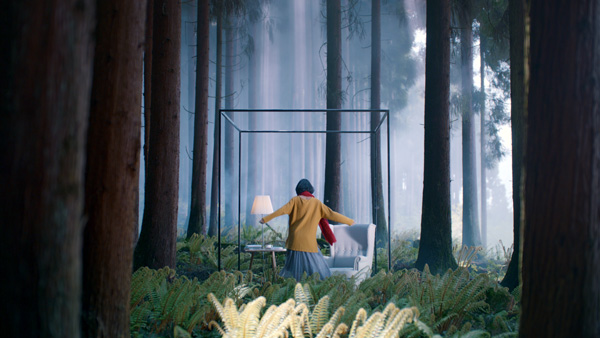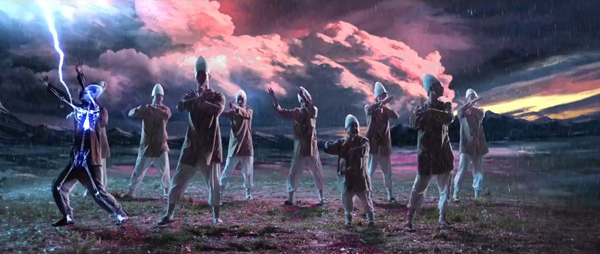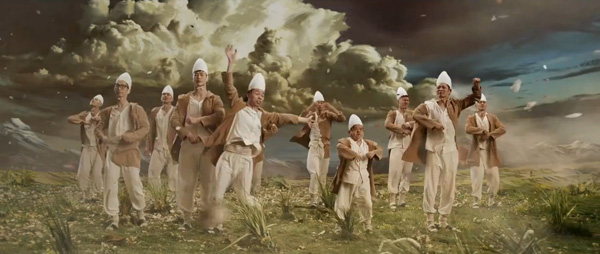Simon Astbury Makes the Grade at Digital Domain

After making false a start in the music industry, Simon Astbury developed an unexpected love for colour grading. During his career of over 20 years, he has worked on projects ranging from ad campaigns and music promos to feature films, in many different genres, and now works as Head of Colour at Digital Domain in Shanghai.
Simon graduated with a degree in music and thought the music industry was where he should be. When his initial experiences in artist representation proved disappointing, he went on to sound sync and dialogue editing in a tiny facility at Twickenham Film Studios where the film technicians were using MkIII Rank Cintel Telecines.
Jumping from Sound to Light
“Once I saw the extraordinary complexity of these systems, with very limited colour tools in those days, programmable effects controllers operated with a tweaker, and primaries, it was love at first sight.
“They had no machine control or editing, so there was no stopping once you’d started. It was a great way to learn the craft, to hone an instinctive reaction to an image that still serves me well today. The green radioactive glow from the tube and smell of film all made grading a much more visceral experience.

“The early '90s was a period of huge change in post. Avid was an intractable new industry trend that the editors mistrusted - most of them were still using Steenbeck flatbed editors at that time.”
As a colourist in London, he had the chance to work on films such as 'Shakespeare in Love', 'Sense and Sensibility', 'Notting Hill' and others, alongside cinematographers including Roger Pratt and Jack Cardiff, and directors Richard Attenborough, Alan Parker and Franco Zeferelli. He even had job with The Spice Girls.
Shanghai Connection
Nevertheless, when the offer came to relocate to Shanghai with Digital Domain, he decided it was time to leave the familiarity of his Soho home. “Digital Domain has been an innovator in post production for almost 25 years, and has an incredible body of work and a global presence. It was also an opportunity to lead and develop a grading department worldwide in a company that is primarily focused on VFX,” he said.

“As Head of Colour, so far this year I’ve introduced some improved workflows in Shanghai and defined training for the juniors and assistants, and I’m trying to make remote grading available to our other offices around the world. I’m also promoting increased co-operation between our Shanghai and Beijing offices. Across these two sites we have some of China’s best commercial and movie grading talent, so I’m making sure that we take advantage of that fantastic resource.”
Thinking about his own strengths as a colourist, he finds that experience is one of his greatest assets, and also what makes him valuable in Shanghai. He said, “I’ve been doing it for a long time and can come up with creative solutions for most eventualities. I try to separate my ego from the work and create a calm but creative atmosphere in the grade suite. The colourist Bob Festa said that he asks people what they want their films to say, rather than how they want them to look, and that’s pretty much my own approach.
Clients First
“Managing client expectations is always very important, but in China the client really is king or queen. Making sure that the work remains good and not diluted by overthinking and over-tweaking is sometimes a very delicate negotiation. Sometimes the client wants you to drive the session and come up with all the ideas, sometimes they want you to do as you are told and sometimes they want it to be a collaboration.
“I’m comfortable with any of these scenarios, but I’d add that the client is paying for my eyes and my interpretation. In other words sometimes you have to take the role of a guide, even when the client has very definite ideas, and be the arbiter of taste. On occasion you have to be firm, particularly when bad decisions are being made - I’ve been compared to an airline pilot or cruise ship captain more than once.”

Consequently, Simon follows a definite routine when grading. Although colour is highly subjective, he believes that the process should not be. Every colourist has a different process, but he strongly believes there’s a right and wrong way of going about a grade. Ways definitely exist that work, as well as those that don’t.
“I’m always on a quest to distil the essence of a grade. A lot of the content I see now is over graded, but we have such comprehensive tools now that you don’t have to throw the kitchen sink at every shot,” he said. “'Keep it simple' is a mantra I try to impress upon my juniors. Furthermore, the longer I do the job, the more important the psychological aspect of it becomes – how your choices in the grade affect the thoughts and emotions of the viewer, what really matters and what doesn’t.”
Redundancy of Process
Another kind of expertise Simon brings to Digital Domain is almost ten years of experience working on the FilmLight Baselight grading system. “What I love best about Baselight is what I call ‘redundancy of process’ by which I mean there are multiple ways of doing most grading operations – if hue angle keying is not working then try Dkey. If Dkey is no good, then try RGB key or curves, and so on. The flexibility as much as the power of the system make it a pleasure to work on.”
As Baselight grew over the years, the developers have never removed any of the creative tools, just refined and added to them. As a result, to achieve a particular look, a colourist can choose from several different tools that affect the image in subtly different ways. Some will be more appropriate than others for a certain type of look on a specific type of scene.
Volumetric Keying

The DKey that Simon mentioned is a specialised keyer that creates a matte according to the colours in an image. The DKey uses volumetric keying to detect a range of colours within an image - sometimes called 3D keying. To do this, the RGB colour space is represented as a cube, with the primary colours on opposite corners, so that all colours in the image can be displayed within this defined colour cube. The colourist then sets up volumes within that cube to specify the range of colours from which he or she wants to create the DKey matte.
For example, if you wanted to affect only the brighter orange-red colours in an image, you could create a matte using the DKey by setting the volume to cover that range of colours. The matte created with this key will isolate the brighter orange-red areas of the image and allow the colourist to work on just those areas – to alter their saturation a little, shift the hue of the colours slightly and so on.
Another characteristic that differentiates the DKey from other types of Baselight keyers, such as the hue angle keyer, is that you can specify more than one volume within the cube. Because that allows more than one range of colours to contribute to the matte, quite subtle, complex keys can be created for tasks like separating out different skin tones on a face that is partly in shadow.
Renderless Workflow
Not surprisingly, given where he works, the fact that Baselight works extremely well for projects with complex visual effects is important. For example, when green screen material and matte painted backgrounds need to be combined in complicated composites, Baselight can be used to assemble rough composites to make sure the grade looks correct. The layer mode composite settings, in particular, give the ability to blend the output of any layer into the current layer, by degrees, with functionality to composite foreground or background images.

The Nuke version of the Baselight Editions plugin, developed specifically for VFX heavy jobs, has a renderless workflow between Baselight and Nuke that Simon said is invaluable.
The VFX artists don't need to wait for graded shots to come back from the colourist, or apply temporary grades that may not accurately preview the final look. Complex grades can be generated directly inside NUKE, including spatial operations such as shapes, Denoise and Add Grain, and keyframes for grades that change over time. By seeing a grade in context, the artist can optimise the important factors for a shot and ignore the elements that the final grade would make unnecessary.
Baselight Grade File
The workflow is based on the Baselight Grade file, BLG, which all Baselight software supports. The BLG is a multi-track OpenEXR file used to create, transfer and review looks. The workflow is also bi-directional so that grades can be created externally and brought into Baselight for Nuke or taken from Nuke back to Baselight as a simple import or export – accessing the grading interface is unnecessary until you need it.
Baselight can act as a multi-input node in Nuke so that BLG files can refer to multiple input images and OpenEXR channels. This allows any composites done in full Baselight to be replicated exactly in Nuke - when you load a BLG that requires multiple inputs, the additional input stalks appear automatically on the node. Colourists can also generate NUKE scripts alongside BLG grade files for EXR input material. The scripts can then be loaded in Nuke so that the inputs and BLG grade are all located and connected automatically with the correct format mappings and colour spaces.
Baselight for Nuke has almost all of the functions of a full copy of Baselight, and even if images have been graded in a full Baselight system, they can be rendered within Baselight for Nuke, allowing final delivery directly from Nuke.
Using Colour

Wu Fang Zhai
After having worked on projects from commercials to documentaries and feature films, in many different genres, Simon said that good, well executed work is the most enjoyable to grade, genre or type notwithstanding. They all represent opportunities to use colour to enhance films. “I love commercials because they afford the opportunity to go into detail and occasionally push things creatively. I love dramas because the story arc and mood can be helped immensely by a good grade. I love documentaries because the grade can enhance the story in so many different ways. I love movies because in my heart I’m a film nut and the opportunity to see your work in a cinema is an incredible buzz that will never ever get old,” said Simon.
“Among a few projects that have stood out for me recently is a grade for the Director Nieto at Stink for a Wu Fang Zhai rice dumplings commercial, shot entirely on green screen. It was great fun to throw away the rule book and do some crazy stuff. I think it came out really well. Jobs that I’ve done over the years that I remember fondly include a travelogue for BBC4 called 'Travels with a Tangerine', which was amazingly well shot on SD DVCAM.

Wu Fang Zhai
“Paul WS Anderson directed some epic spots for Audi, and I worked on a multi-screen art installation titled 'Mother’s Day' for the artist Smadar Dreyfuss about dispossessed stateless children in Israel. Working with younger directors like Stella Scott has been a great experience – passing on knowledge and at the same time learning a new visual language help to keep everything fresh.”
Glass and Lighting
Simon has now been a colourist for over 20 years and witnessed the time when colour correction was processed in film labs. He worked exclusively in film for about half of his career and still loves it. He said, “It is tactile, it smells great, it feels good in your hands and of course many of the most memorable images in cinema were shot on it. The soft detail, intensity and richness of colour, the roll off into the whites and blacks is something that digital still finds hard to replicate.
“The recent resurgence in Europe and the USA of film in shorts, commercials and promos is great to see. However, I find myself thinking about all those things I don’t miss about film such as weave, cell scratches, grain, wet gate TK and that buttock clenching moment when the lab manager tells you the reel has broken in the bath and 300 feet of neg has been destroyed. X-ray fogging! I have so many film horror stories.
“Modern cameras produce amazingly clear images with great colour and response to light, and far fewer insurmountable problems, but I don’t see either as particularly better. Actually, decent glass and proper lighting are just as important as what camera or format you shoot on.”

Saying 'Yes'
Simon sees a few challenges ahead in his career, but most are not specific to colourists. “Content is becoming continually more disposable. It’s more important than ever that respect for the craft, not only of colour grading but the whole production and post process, becomes central to every production. The proliferation of display devices is also a big subject, because making sure that the grade looks good on phones, tablets, laptops and TV is an issue that will only get more challenging.”
He advises junior colourist starting out today to be patient. There are no shortcuts to a polished grade, although the process takes less time now than earlier on due to the absence of telecines. “Be a geek about your industry, cameras, lighting, lenses. Watch movies, ads and everything that’s good. Study art and artists, if only to have common points of reference,” he said.
“Remember that the grading part is only a portion of what makes a good colourist. You’re the host, therapist, barman and ringmaster. You have to be someone people don’t mind spending 12 hours in a dark room with - otherwise they’ll never use you again. With difficult client requests try to say yes and then work out how you’re going to do it. If you can’t do it, suggest an alternative rather than saying no.” www.filmlight.ltd.uk



